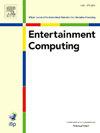Design and implementation of a survival game towards achieving user’s satisfaction by providing balanced difficulty
IF 2.8
3区 计算机科学
Q2 COMPUTER SCIENCE, CYBERNETICS
引用次数: 0
Abstract
Recently due to high popularity of video games, Procedural Content Generation (PCG) becomes an approach for automatically creating levels in game with balanced difficulty. The PCG is a solution towards automatic creation of levels with balanced difficulty. Among the existing works, not only very few recent PCG-based difficulty balancing solutions is found, but algorithms are also computationally intensive due to the presence of complex techniques like evolutionary computing, graph algorithms etc. In this paper, we develop a low overhead mathematical model based PCG scheme with the rule of variation and curve fitting. Firstly, relationship between difficulty and performance parameters of the game is setup using this model. Then, to make the model more reliable, difficulty parameters are adjusted to cope with the real performance of a player. Finally, the proposed scheme is tested on a survival game ‘Helip’ developed by us. The game shows satisfactory performance in response time, user friendliness, visual aesthetics and innovation based on opinion of the players. Moreover, the proposed difficulty balancing scheme is evaluated in terms of opinion score and player’s performance to be more balanced compared to state-of-the-art techniques. Our balancing scheme also has the lowest overhead in terms of running time.
求助全文
约1分钟内获得全文
求助全文
来源期刊

Entertainment Computing
Computer Science-Human-Computer Interaction
CiteScore
5.90
自引率
7.10%
发文量
66
期刊介绍:
Entertainment Computing publishes original, peer-reviewed research articles and serves as a forum for stimulating and disseminating innovative research ideas, emerging technologies, empirical investigations, state-of-the-art methods and tools in all aspects of digital entertainment, new media, entertainment computing, gaming, robotics, toys and applications among researchers, engineers, social scientists, artists and practitioners. Theoretical, technical, empirical, survey articles and case studies are all appropriate to the journal.
 求助内容:
求助内容: 应助结果提醒方式:
应助结果提醒方式:


